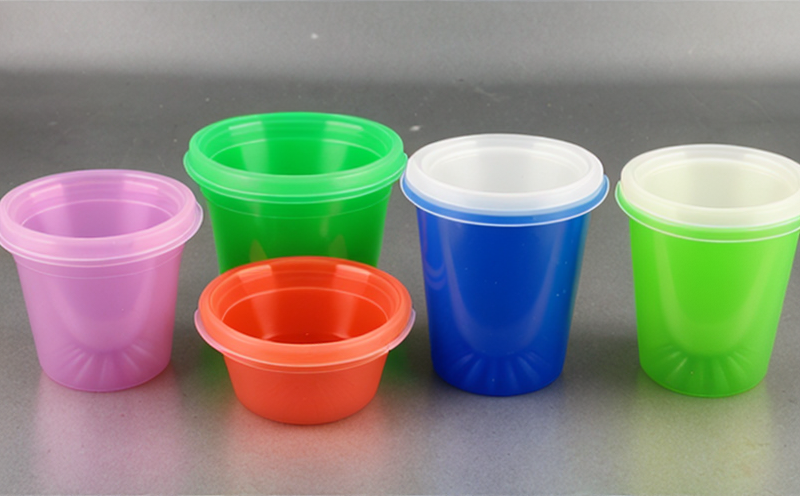ASTM G155 Xenon Arc Weathering Testing of Disposable Plastics
The ASTM G155 standard provides a method to simulate the effects of ultraviolet (UV) light, heat, and moisture exposure on materials used in disposable plastics. This testing is crucial for ensuring that products like single-use containers, films, and packaging withstand environmental conditions without degrading prematurely.
ASTM G155 utilizes a Xenon Arc lamp to simulate the effects of sunlight, including UV radiation, visible light, and heat. The test is particularly important in industries where extended exposure to natural elements could significantly impact product performance. For disposable plastics, this could mean ensuring that packaging remains intact during distribution or that medical disposables maintain their integrity throughout storage.
The testing process involves exposing the plastic specimens to a controlled environment designed to mimic real-world conditions. This helps manufacturers and suppliers evaluate how well their products can withstand exposure without losing functionality or safety. The results provide critical data for product development, quality assurance, and regulatory compliance.
One of the key aspects of ASTM G155 testing is understanding its relevance in different sectors. For instance, in the healthcare industry, ensuring that syringes, IV tubing, and other disposable medical devices maintain their strength and sterility under environmental stress is essential. Similarly, in food packaging, maintaining the integrity and safety of plastic wraps and containers is vital to prevent contamination.
The test parameters for ASTM G155 are meticulously designed to replicate various environmental factors. Specimens are exposed to high-intensity ultraviolet light at specific wavelengths (typically 280-400 nm) for defined periods, often accompanied by humidity cycling. The process is closely monitored using specialized equipment that captures changes in the specimens over time.
The acceptance criteria for ASTM G155 testing depend on the application of the plastic material. For instance, in packaging applications, a significant reduction in light transmittance or color change might indicate unacceptable degradation. In medical devices, maintaining mechanical properties and sterility is paramount. Compliance with these criteria ensures that products meet regulatory standards and perform reliably under expected environmental conditions.
Understanding the impact of ASTM G155 testing on customer satisfaction is crucial for any quality manager or compliance officer responsible for ensuring product integrity. By conducting this testing, manufacturers can demonstrate a commitment to high-quality products that meet industry standards. This not only enhances brand reputation but also fosters trust among consumers and regulatory bodies.
- Ensures long-term performance of disposable plastics in various environments.
- Promotes compliance with international standards and regulations.
- Aids in the development of more durable and reliable products.
- Enhances customer satisfaction by delivering consistent quality.
In summary, ASTM G155 testing is a vital tool for ensuring that disposable plastics meet rigorous environmental durability requirements. By simulating real-world conditions, this test provides critical insights into the performance of materials under stress, ultimately contributing to safer and more reliable products.
Why It Matters
The importance of ASTM G155 testing in the context of disposable plastics cannot be overstated. In sectors like healthcare and food packaging, where product integrity is paramount, ensuring that materials do not degrade prematurely can save lives or prevent contamination.
For instance, in medical applications, the failure of a single-use syringe due to environmental exposure could lead to serious health risks. Similarly, compromised food packaging could result in product spoilage and potential public health issues. By adhering to ASTM G155 standards, manufacturers can significantly reduce these risks.
The test also plays a crucial role in ensuring regulatory compliance. Many industries have strict requirements for the durability of disposable plastics. For example, the FDA has specific guidelines for medical disposables that must withstand environmental stress without compromising safety or efficacy. Conducting ASTM G155 testing helps manufacturers meet these stringent standards.
Furthermore, consumer trust is a critical factor in the success of any product line. By demonstrating consistent quality through rigorous testing, companies can build and maintain a reputation for reliability. This not only enhances customer satisfaction but also fosters long-term loyalty.
In conclusion, ASTM G155 testing is essential for ensuring the durability, safety, and compliance of disposable plastics across various sectors. Its role in enhancing product performance and regulatory adherence cannot be overlooked.
Quality and Reliability Assurance
ASTM G155 testing plays a pivotal role in quality and reliability assurance for disposable plastics. By simulating real-world environmental conditions, this test helps manufacturers identify potential weaknesses in their products before they reach the market.
The process begins with selecting appropriate specimens that represent the intended use of the product. These specimens are then exposed to controlled environmental conditions using a Xenon Arc lamp. The exposure parameters are carefully chosen based on the specific application and expected usage environment.
After exposure, the specimens undergo rigorous analysis to assess any changes in physical properties such as tensile strength, elongation at break, and color. Visual inspections are also conducted to detect any signs of degradation or cracking. The results provide valuable insights into how well the product withstands environmental stress.
The data generated from ASTM G155 testing is crucial for quality assurance teams. It allows them to identify areas where improvements can be made in material selection, design, and manufacturing processes. This information is also used to develop more robust specifications that ensure consistent performance across all batches of products.
Reliability assurance through ASTM G155 testing ensures that manufacturers meet or exceed industry standards. Compliance with these standards not only enhances product quality but also reduces the risk of recalls and legal issues. By adhering to international standards such as ISO, ASTM, EN, IEC, etc., companies can demonstrate their commitment to excellence and build trust with customers.
In summary, ASTM G155 testing is an indispensable tool for ensuring the quality and reliability of disposable plastics. Its role in identifying potential issues early on and meeting regulatory requirements makes it a cornerstone of modern manufacturing practices.





